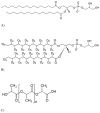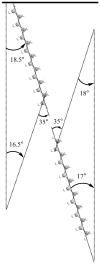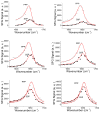Single Lipid Bilayers Constructed on Polymer Cushion Studied by Sum Frequency Generation Vibrational Spectroscopy
- PMID: 21712964
- PMCID: PMC3122884
- DOI: 10.1021/jp200546h
Single Lipid Bilayers Constructed on Polymer Cushion Studied by Sum Frequency Generation Vibrational Spectroscopy
Abstract
Planar solid supported single lipid bilayers on mica, glass, or other inorganic surfaces have been widely used as models for cell membranes. To more closely mimic the cell membrane environment, soft hydrophilic polymer cushions were introduced between the hard inorganic substrate and the lipid bilayer to completely avoid the possible substrate-lipid interactions. In this article, sum frequency generation (SFG) vibrational spectroscopy was used to examine and compare single lipid bilayers assembled on the CaF(2) prism surface and on poly (L-lactic acid) (PLLA) cushion. By using asymmetric lipid bilayers composed of a hydrogenated 1,2-dipalmitoyl-sn-glycerol-3-phosphoglycerol (DPPG) leaflet and a deuterated 1,2-dipalmitoyl-(d62)-sn-glycerol-3-phosphoglycerol (d-DPPG) leaflet, it was shown that the DPPG lipid bilayers deposited on the CaF(2) and PLLA surfaces have similar structures. SFG has also been applied to investigate molecular interactions between an antimicrobial peptide Cecropin P(1) (CP1) and the lipid bilayers on the above two different surfaces. Similar results were again obtained. This research demonstrated that the hydrophilic PLLA cushion can serve as an excellent substrate to support single lipid bilayers. We believe that it can be an important cell membrane model for future studies on transmembrane proteins, for which the possible inorganic substrate-bilayer interactions may affect the protein structure or function.
Figures







Similar articles
-
Molecular interactions between cell penetrating peptide Pep-1 and model cell membranes.J Phys Chem B. 2012 Mar 1;116(8):2545-52. doi: 10.1021/jp209604m. Epub 2012 Feb 17. J Phys Chem B. 2012. PMID: 22292835 Free PMC article.
-
Membrane orientation of MSI-78 measured by sum frequency generation vibrational spectroscopy.Langmuir. 2011 Jun 21;27(12):7760-7. doi: 10.1021/la201048t. Epub 2011 May 19. Langmuir. 2011. PMID: 21595453 Free PMC article.
-
SFG studies on interactions between antimicrobial peptides and supported lipid bilayers.Biochim Biophys Acta. 2006 Sep;1758(9):1257-73. doi: 10.1016/j.bbamem.2006.01.017. Epub 2006 Feb 17. Biochim Biophys Acta. 2006. PMID: 16524559 Review.
-
Membrane interaction of antimicrobial peptides using E. coli lipid extract as model bacterial cell membranes and SFG spectroscopy.Chem Phys Lipids. 2015 Apr;187:20-33. doi: 10.1016/j.chemphyslip.2015.02.003. Epub 2015 Feb 20. Chem Phys Lipids. 2015. PMID: 25707312 Free PMC article.
-
In situ molecular level studies on membrane related peptides and proteins in real time using sum frequency generation vibrational spectroscopy.J Struct Biol. 2009 Oct;168(1):61-77. doi: 10.1016/j.jsb.2009.03.006. Epub 2009 Mar 21. J Struct Biol. 2009. PMID: 19306928 Free PMC article. Review.
Cited by
-
Dependence of Alamethicin Membrane Orientation on the Solution Concentration.J Phys Chem C Nanomater Interfaces. 2013 Feb 21;117(7):3358-3365. doi: 10.1021/jp3099522. Epub 2013 Jan 24. J Phys Chem C Nanomater Interfaces. 2013. PMID: 23565299 Free PMC article.
-
Interkingdom signaling: integration, conformation, and orientation of N-acyl-L-homoserine lactones in supported lipid bilayers.Langmuir. 2012 Jun 5;28(22):8456-62. doi: 10.1021/la301241s. Epub 2012 May 17. Langmuir. 2012. PMID: 22568488 Free PMC article.
-
Membrane orientation and binding determinants of G protein-coupled receptor kinase 5 as assessed by combined vibrational spectroscopic studies.PLoS One. 2013 Nov 22;8(11):e82072. doi: 10.1371/journal.pone.0082072. eCollection 2013. PLoS One. 2013. PMID: 24278472 Free PMC article.
-
Lipid Fluid-Gel Phase Transition Induced Alamethicin Orientational Change Probed by Sum Frequency Generation Vibrational Spectroscopy.J Phys Chem C Nanomater Interfaces. 2013 Aug 20;117(33):17039-17049. doi: 10.1021/jp4047215. J Phys Chem C Nanomater Interfaces. 2013. PMID: 24124624 Free PMC article.
-
Membrane orientation of Gα(i)β(1)γ(2) and Gβ(1)γ(2) determined via combined vibrational spectroscopic studies.J Am Chem Soc. 2013 Apr 3;135(13):5044-51. doi: 10.1021/ja3116026. Epub 2013 Mar 21. J Am Chem Soc. 2013. PMID: 23461393 Free PMC article.
References
Grants and funding
LinkOut - more resources
Full Text Sources
